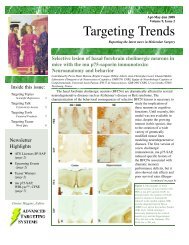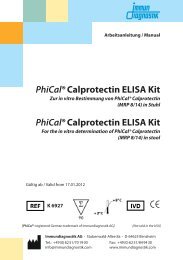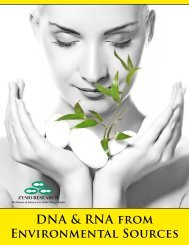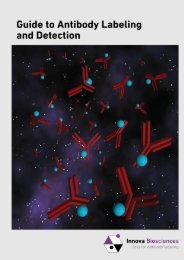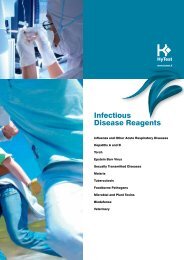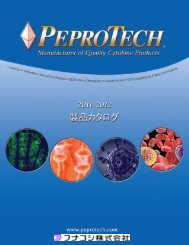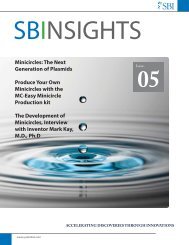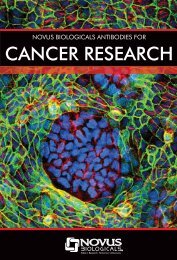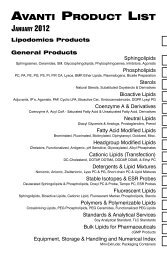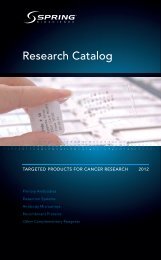Thermo Scientific Pierce Crosslinking Technical Handbook
Thermo Scientific Pierce Crosslinking Technical Handbook
Thermo Scientific Pierce Crosslinking Technical Handbook
You also want an ePaper? Increase the reach of your titles
YUMPU automatically turns print PDFs into web optimized ePapers that Google loves.
Crosslinker Reactivities<br />
aqueous solutions; however, it is possible to achieve greater<br />
solubility when the reagent is dissolved in organic solvents such<br />
as DMSO (Product # 20688). The water-soluble NHS-ester crosslinkers<br />
are used for cell-surface conjugation because they will<br />
not permeate the membrane. Sulfonated NHS-ester crosslinkers<br />
are supplied as sodium salts and are soluble in water to a<br />
concentration of at least 10 mM.<br />
The solubility of the NHS-esters will vary with buffer composition.<br />
The non-sulfonated forms of NHS-ester reagents are waterinsoluble<br />
and are first dissolved in water-miscible organic<br />
solvent, such as DMSO (Product # 20688) and DMF (Product<br />
# 20672, 20673), then added to the aqueous reaction mixture. The<br />
water-insoluble crosslinkers do not possess a charged group and<br />
are lipophilic and membrane-permeable. <strong>Crosslinking</strong> reactions<br />
with the water-insoluble NHS-esters are typically performed with<br />
a solvent carryover of 0.5-10% final volume in the aqueous reaction.<br />
In some cases, crosslinking proteins with NHS-esters may result<br />
in loss of biological activity that may be a result of conformational<br />
change of the protein when the NHS-ester crosslinker reacts with<br />
primary amines on the molecule’s surface. Loss of activity may<br />
also occur when any of the lysine groups involved in binding a<br />
substrate (in the case of an enzyme) or an antigen (in the case of<br />
an antibody) are modified by the crosslinker.<br />
Sulfhydryl-reactive chemistries<br />
Maleimides<br />
Coupling through sulfhydryl groups is advantageous because it can<br />
be site-directed, yield cleavable products and allow for sequential<br />
coupling. A protein in a complex mixture can be specifically labeled<br />
if it is the only one with a free sulfhydryl group on its surface. If<br />
there are insufficient quantities of free sulfhydryls, they can be<br />
generated by reduction of disulfide bonds. Alternatively, sulfhydryls<br />
can be introduced into molecules through reaction with primary<br />
amines using 2-Iminothiolane or Traut’s Reagent (Product # 26101),<br />
SATA (Product # 26102), or SPDP (Product # 21857).<br />
The maleimide group reacts specifically with sulfhydryl groups<br />
when the pH of the reaction mixture is between pH 6.5 and 7.5 and<br />
forms a stable thioether linkage that is not reversible (Figure 8).<br />
At neutral pH, maleimides react with sulfhydryls 1,000-fold faster<br />
than with amines, but at pH >8.5, the reaction favors primary<br />
amines. Maleimides do not react with tyrosines, histidines or<br />
methionines. Hydrolysis of maleimides to a nonreactive maleamic<br />
acid can compete with thiol modification, especially above pH 8.0.<br />
Thiols must be excluded from reaction buffers used with<br />
maleimides because they will compete for coupling sites. Excess<br />
maleimides can be quenched at the end of a reaction by adding<br />
free thiols. EDTA can be included in the coupling buffer to minimize<br />
oxidation of sulfhydryls.<br />
Sulfhydrylcontaining<br />
molecule<br />
Maleimide<br />
compound<br />
Figure 8. Maleimide reaction scheme.<br />
Thioether bond<br />
Haloacetyls<br />
The most commonly used α-haloacetyl crosslinkers contain the<br />
iodoacetyl group that reacts with sulfhydryl groups at physiological<br />
pH. The reaction of the iodoacetyl group with a sulfhydryl proceeds<br />
by nucleophilic substitution of iodine with a thiol producing a stable<br />
thioether linkage (Figure 9). Using a slight excess of the iodoacetyl<br />
group over the number of sulfhydryl groups at pH 8.3 ensures<br />
sulfhydryl selectivity. In the absence of free sulfhydryls, or if a<br />
large excess of iodoacetyl group is used, the iodoacetyl group can<br />
react with other amino acids. Imidazoles can react with iodoacetyl<br />
groups at pH 6.9-7.0, but the incubation must proceed for longer<br />
than one week.<br />
Histidyl side chains and amino groups react in the unprotonated<br />
form with iodoacetyl groups above pH 5 and pH 7, respectively. To<br />
limit free iodine generation, which has the potential to react with<br />
tyrosine, histidine and tryptophan residues, perform iodoacetyl<br />
reactions and preparations in the dark. Avoid exposure of iodoacetyl<br />
compounds to reducing agents. Available NHS-ester haloacetyl<br />
crosslinkers are listed in Table 3.<br />
Sulfhydrylcontaining<br />
molecule<br />
Iodoacetyl<br />
compound<br />
Figure 9. Active halogen reaction scheme.<br />
Thioether bond<br />
Table 3. <strong>Thermo</strong> <strong>Scientific</strong> <strong>Pierce</strong> NHS-ester Haloacetyl Crosslinkers.<br />
Reagent Reactivity Product #<br />
SIA Amine/Sulfhydryl 22349<br />
SIAB Amine/Sulfhydryl 22329<br />
Sulfo-SIAB Amine/Sulfhydryl 22327<br />
18<br />
For more information, or to download product instructions, visit www.thermo.com/pierce



